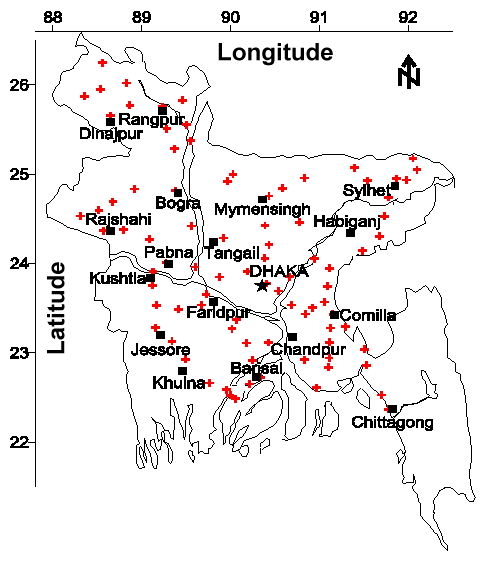Groundwater samples were collected from 112 tubewells throughout Bangladesh during 20 December 1998 to 18 January 1999. One sample was collected from each tubewell. All of these samples were analyzed for Ag, Al, As, Ba, Bi, Ca, Cd, Co, Cr, Cs, Cu, F-, Fe, H+, K, Mg, Mn, Mo, Ni, Pb, Rb, S, Sb, Si, Se, Sr, Tl, V, W, and Zn.
The sampled tubewells were distributed as evenly throughout Bangladesh as possible, given limited access because of the country’s extensive river delta and developing network of roads (Figure 1). Random samples were typically collected by traveling on roads and across rivers for 20-30 km, stopping at a random location, and collecting groundwater from the first tubewell we found. The latitude and longitude of these tubewells were determined using a Garmin Global Positioning System 12-channel Personal Navigator (Garmin International, Inc., Olathe, KS, USA). The accuracy of this instrument was approximately 15 m. The district, thana (a collection of villages or section of a city under the jurisdiction of a single police station), and village of all sampled tubewells were documented. The owner and the owner’s reported depth of each sampled tubewell were recorded.
 |
Established collection, preservation, and storage methodologies were used to ensure that each sample was representative of groundwater quality (12,19). Accordingly, all sampled tubewells were purged by vigorous pumping for 10 min immediately before sample collection. All samples were collected directly into polyethylene bottles and were not filtered. Samples were analyzed for pH immediately after collection by glass electrode or pH paper, preserved by acidification to pH < 2 with 18.6% (weight/weight) HNO3, and stored in ice-packed coolers. The temperature of all stored samples was maintained at 0º to 4º C until immediately before analysis.
All samples were analyzed for Mg, Al, Ca, V, Cr, Mn, Co, Ni, Cu, Zn, As, Se, Rb, Sr, Mo, Ag, Cd, Sb, Cs, Ba, W, Tl, Pb, and Bi at the Laboratoire Pierre Süe, Centre National de la Recherche Scientifique in Gifsur-Yvette, France. These samples were analyzed by inductively coupled plasma mass spectrometry (ICP/MS) with a Fisons PlasmaQuad PQ2+ spectrometer (Fisons/VG Analytical, Manchester, UK). Multielement standard solutions were prepared from solutions certified by SPEX CertiPrep, Inc. (Metuchen, NJ). Monoelemental SPEX CertiPrep-certified solutions of Be, In, and Re were used as internal standards. All samples were analyzed twice by ICP/MS. First, undiluted samples were analyzed for trace elements. Then samples were diluted 10 times using ultrapure water and acidified to pH 2 with Prolabo Normatom I grade nitric acid (Prolabo, Paris, France) for the determination of major elements (20,21).
All samples were analyzed for Si, S, K, and Fe at the Université de Bordeaux 1, Laboratoire de Chimie Nucléaire Analytique et Bioenvironnementale, in Gradignan, France. These samples were analyzed by particle induced X-ray emission Rutherford backscattering spectrometry with the 4 MV Van de Graaff accelerator and nuclear microprobe beamline (22,23). Multielement standard solutions were prepared from Sigma-certified solutions (Sigma Aldrich Chimie, Lyon, France). Yttrium at a final concentration of 50 mg/L was used as an internal standard. All samples were analyzed for F- at the Laboratoire de Chimie Nucléaire Analytique et Bioenvironnementale by fluoride-selective electrode by established methods (12).